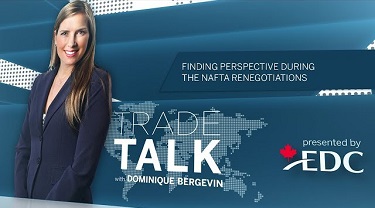Canada-U.S. trade is worth $1 billion dollars per day. It can be hard to fathom what that amount of money looks like. As economists, we bandy about a lot of big numbers. But a billion dollars in daily trade value is a lot. If you put a billion goldfish together in one place, you’d need a bowl the size of a football stadium to hold them. A billion dollars can buy you 5,000 high-end Porsches with a price-tag of $200,000 apiece. That gives you some idea of the significance of Canada’s trade relationship with our southern neighbour.
It’s no wonder the NAFTA renegotiation has some Canadian businesses worried about the future of Canada-U.S. trade. Some firms are already thinking of plan B – setting up shop in the U.S. to skirt any trade changes or dispute that may arise out of NAFTA. In our fall survey of 1,000 Canadian exporters, The Trade Confidence Index, 23% of Canadian businesses said the Canada-U.S. trade talks were negatively impacting their Canadian operations. Of those, 26% of businesses indicated they would consider moving Canadian operations to the United States.
Investing in the U.S. is a good thing; it can be a positive move for any Canadian business to establish international operations that brings them closer to their customers. But is this the best game plan for your business? Maybe so, but it doesn’t have to be done as a kneejerk reaction to the NAFTA talks.
That $1 billion value of goods and services that cross the 49th parallel daily is just one reason among several I list in this video on 7 Reasons NAFTA can’t fail. It would take a long time to find investment to fill the void if NAFTA were to collapse. US trade with NAFTA partners supports 2.8 million American jobs; free trade keeps the cost of goods down for American consumers. And with technology continuing to fuel greater globalization, America’s isolationist stance doesn’t fit with the overall trends around the world. Will the U.S. sacrifice more than two decades of lucrative trade relations with Canada and Mexico to become more protectionist nearly a decade after the global recession?
For Canadian businesses, finding new customers and generating international sales is integral to growth. The past year opened up some stellar opportunities for Canadian businesses to sell and invest in Europe, Latin America and other emerging markets. These are all increasing access to millions of new consumers, investment opportunities and business partnerships for Canadian enterprises.
The NAFTA renegotiation has some Canadian businesses concerned. Should they wait and see what kind of tariff barriers or hostilities come out of the NAFTA negotiations? Or should they urgently put those “plan Bs” into action and take the bold step of moving operations or aspects of their manufacturing into the U.S. now, just in case the whole NAFTA thing doesn’t work out?
Moving operations to the U.S. isn’t necessarily a bad plan, regardless of what happens with the NAFTA talks. International investment often makes good business sense, offers risk mitigation against border disputes and tariff changes, and is a buffer in times of global instability. Having operations in other countries also offers a hedge against currency fluctuations and interest rates.
But reactive investing in America should be carefully considered and planned out before you make a move.
1. Are you ready to operate in U.S. dollars?
Shifting to a U.S. dollars cost-base is a first consideration. Mark these up 30% immediately, given the current value of the Canadian dollar.
2. Can you access the labour you need?
Globally, finding skilled labour is tough. Finding skilled labour in the U.S. is particularly challenging right now, with their official unemployment rate at 4.1 per cent – about as low as it ever gets. Expect to pay top dollar to attract the workers you need.
3. Can you access the facilities you need?
Spare industrial space is very limited in a large number of industries in the United States. Don’t expect that you will be able to find walk-in facilities. And if you need space built, not only does that normally take time, but at the moment, you’ll have to get in line – lots of other businesses are also trying to expand.
4. Is your buyer willing to pay more?
The U.S. is generally a higher-cost market, but current conditions are boosting the cost even higher. By the time you’ve paid for labour, space and the currency exchange, it adds up. Has your product got enough value add to boost prices to cover your increased costs?
5. What is the size of the investment required to move to the U.S.?
If you are betting the farm on the move, and hadn’t really been contemplating it before all this negative talk about NAFTA, consider it very carefully before making the move. Locating internationally is always a good thing to examine. The opportunities for market access, on top of supply chain integration and optimization, can revolutionize your business opportunities.
Canadian companies that have set up U.S. operations have told us and shown us that their investment offers a lot of benefits. Being in close proximity to clients and having staff on the ground where they can deal with regulations and logistics and offer better customer service are all positive reasons to establish operations in the market where you sell. And even though there are initial and ongoing operational costs that are higher, once you get over some of the hurdles of investment, there are also cost savings to be had in these areas as well.
It’s definitely good for business to invest internationally. But do it with careful planning and for the right reasons – do it to grow your business internationally, to mitigate risk and to hedge against currency volatility, not out of fear that NAFTA will expire.






